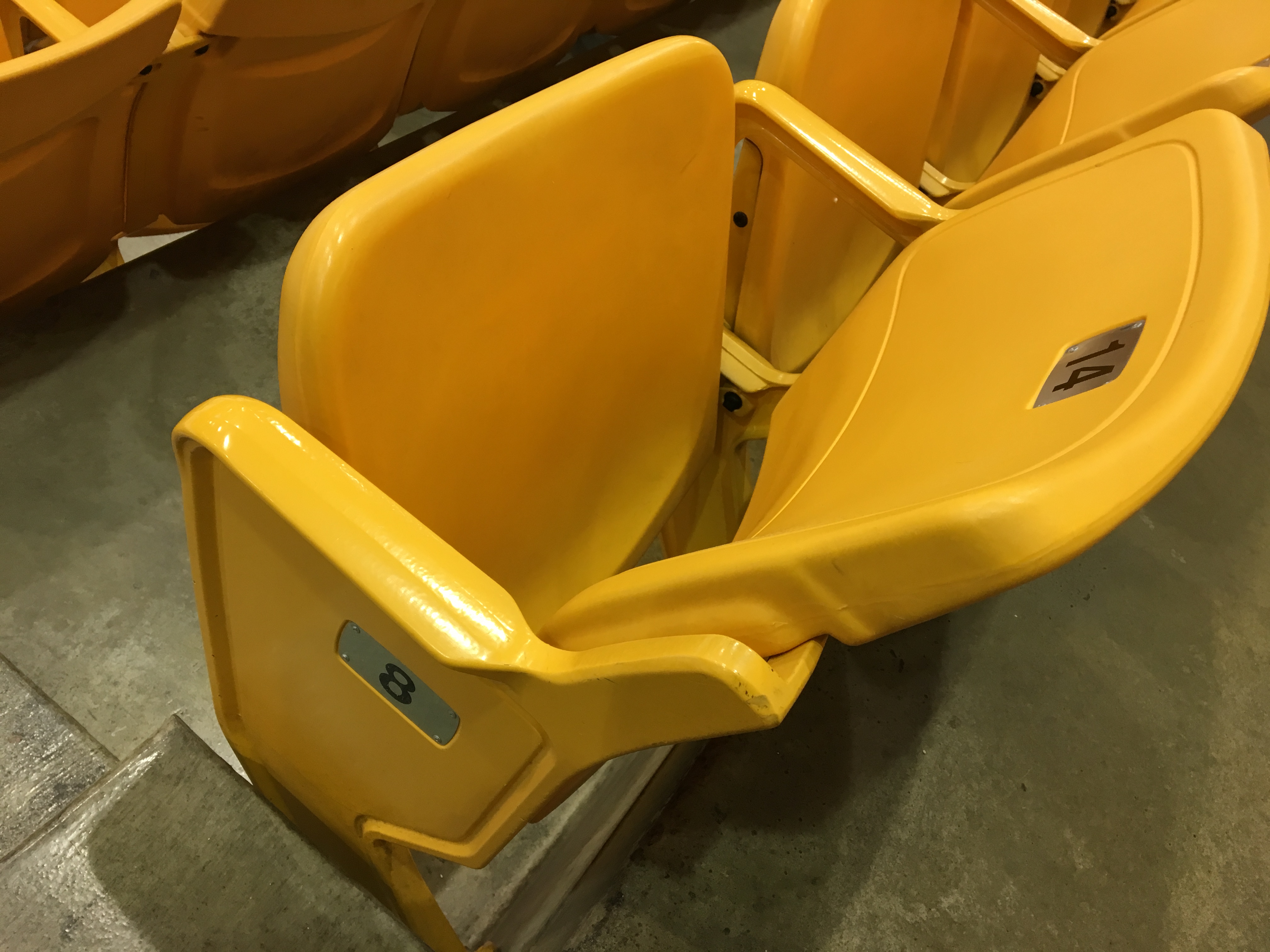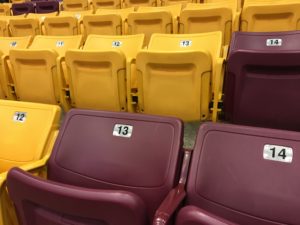
You could hear our shivers. We hummed like refrigerators in our plastic seats, our frigid winter jackets micro-trembling, heat dissipating up, up, up into the bannered rafters.
Thirty-seven minutes until game time, little pockets of people huddled among the 7,000-some seats, clouded breath hanging above each huddle, as if above snorting bison on the windless prairie.
Almost.
On the ice, ponytails bounced and whipped from under shiny helmets. Big, white, upper-middle-class smiles sparkled through the sodium-light reflections on plastic facemasks. Tiny sprays of ice dust lifted from each turn of sharpened blades, timed to the sharp Thack-, Thack-, Thacking of sticks on pucks, and of sticks on ice, or the occasional Cloink of a puck on a sniped crossbar.
We could see all of this because we were in the first row. Again.
Those smiles and swooshes and Thacks and Cloinks competed with the reverberating pop, or hippity hoppity, or whatever combinations of noises and croonings sound cool or frigid to college kids these days. Bass echoed upward into the expanse of the concrete cavern of cool, this occasional hockey mecca of Minnesota.
Later that night, anyway. This afternoon, it is an empty temple of Title IX.
The men’s team—repeat national champions, the hottest ticket in town—would play four hours later. Then, thousands of solitary celebrations would coalesce into raucous cheers. The cameras would whirr, the play-by-play commentators for radio and local TV and the conference’s online network would fight to be heard above the din.
Here, now, dim are the advertisements for soft drinks and potato chips and banks. One concession stand is open—the others are shuttered with aluminum grates—a college-age girl in a black jacket leaning against an idle popcorn machine glowing bright yellow, shifting from foot to foot as at least six people walk by before stepping down, down, down the aisles to their de facto ice-level seats—matinee-priced, discount VIPs.
And where to sit? Hm, there’s a whiny kid running up and down the front row of that section—better give him at least fifty feet. How about over here? No, there’s someone in that row; let’s pick the one below. What, you want to sit right above the players’ tunnel? Okay, let’s pick up our stuff before we move—and watch out for that one seat that’s down in the row of seventeen other empties—you’ll catch a knee.
General admission, indeed.
In four hours, in this exact spot there would be awkward climbing over people, purses, and popcorn tubs, knee-wrestlings over Excuse Me’s, plopping into seats after triple-checking seat numbers. Here, now, the little-stainless seat badges glisten in perfect rows… 14… 15… 16… forever. One’s mind wanders to wonder if we could pull off a Magellan magic act, and walk the entire oval row without bumping into another fan, only to return, semi-victorious in a Daytona of 500 empty seats.
One’s mind also wanders to money. Who paid for all of this? The ice time in a city where hundreds of others would pay thousands just to practice mid-afternoon? Who pays the idle concession worker? The six-figure coaching salary? The thousands tied up above the pony tails in shiny helmets? Not us, with our two tickets for seven dollars, one of seventy-seven people in a sodium-lit, refrigerated airplane hangar. Not us, with our four-dollar hot dog.
They say that schools make money off of college athletics. That the TV contracts and the ad revenue and the ticket sales go into athletic directors’ and coaches’ pockets. That the young men in front of the screaming thousands deserve a slice of the pie.
But other people eat that pie, too. We forget that we’ve spent a lot of that money on the opening act, the matinee of women’s sports, a spectacle of women who work just as hard as the men, who sweat and bleed and cuss and want to win just as much, of course. These women, though—while inspirations to young girls and to us all—are playing with other people’s money. The men’s money, or the men’s fans’, or the men’s advertisers’, anyway. The main event pays for… everything else, everybody else.
Is that good? Sure. But it’s not free. Some pay so all can play.
Should we pay the players? Maybe. But which players? The players who are supposedly exploited by the system of commercial college athletics? What about the college athletes whose sports lose… hemorrhage… cash? The women, say, who play the same game, against the same schools, with the same travel schedule, and the same workouts… in front of ten percent of the fans, and one percent of the television audience, if there is one at all?
Why don’t we call these women exploited, too? Because their work—the same work—doesn’t result in a product that people buy? That sounds separate and… unequal.
Here’s a question that, seemingly, is whispered only in the echoes of an empty arena: if it’s exploitation, who’s actually exploiting whom?
And what about the other athletes who are more obviously swimming and diving in a pool of football’s and basketball’s cash? Both men’s and women’s swimming and diving teams are drowning in the red. The women’s softball team and men’s baseball team and women’s soccer team and men’s soccer team and women’s volleyball team and men’s wrestling team are just as big as—or bigger than—the men’s basketball team, and therefore cost just as much or more money to jettison to the same college towns in the same conference, week after week… while losing their shirt, or jersey, even if they win the games.
That… adds up.
The big-money college athletes have been likened to slaves, or serfs, funding the sports-industrial complex of administrators and coaches and fancy training complexes, all in-between commercial breaks. Again, maybe, but only if we keep one eye closed. Because if they’re those things, they’re also the ultimate charity workers. Sometimes, one hundred young men attract one hundred-thousand paying fans just by stepping onto green turf, but they take none of that green, or very little of it, and instead give it to… young women wearing skates on a Saturday afternoon in a Land of 10,000 seats.
That’s kind of literally true: today we’re playing Ohio State. You know, “The” Ohio State. As evidence, there are at least… four people wearing red in here.
Maybe those young men on turf aren’t being robbed—or if they are, it’s not just by rich white men in suits. Or, maybe it’s not robbery at all: maybe they’re the Robin Hoods of shiny helmets, riding pommel horses lacrosse-country over tracks and outfields, and making all sorts of racket(s) as they jump through hoops. Or something. In one fell swoosh on a jersey, these men can go from victims to valiant.
They’re the philanthropists of en-Title-IX programs.
Pay the players? Hm. Which players? How much? In which sports?
It’s a shivering thought.

P. A. Jensen is editor of RuralityCheck.com.
He lives in northern Minnesota with his wife and son.



